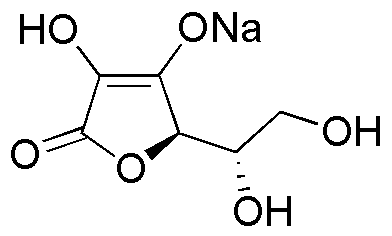(+)-Sodium L-ascorbate crystalline is widely utilized in research focused on:
- Food Preservation: This compound acts as a powerful antioxidant, helping to extend the shelf life of food products by preventing oxidation. It is commonly used in the food industry to maintain freshness and color in fruits, vegetables, and processed foods.
- Cosmetic Formulations: Due to its skin-brightening properties, it is frequently included in skincare products. It helps reduce pigmentation and improve skin texture, making it a popular choice for creams and serums aimed at enhancing skin health.
- Pharmaceutical Applications: This chemical is utilized in various medicinal formulations, particularly in vitamin C supplements. Its bioavailability makes it an effective option for enhancing the immune system and overall health.
- Research in Biochemistry: It serves as a reducing agent in biochemical assays, aiding in the study of enzyme activities and metabolic pathways. Researchers appreciate its stability and effectiveness in laboratory settings.
- Agricultural Uses: The compound is applied in agriculture as a plant growth enhancer. It can improve the health and yield of crops by promoting better nutrient absorption and reducing oxidative stress in plants.
General Information
Properties
Safety and Regulations
Applications
(+)-Sodium L-ascorbate crystalline is widely utilized in research focused on:
- Food Preservation: This compound acts as a powerful antioxidant, helping to extend the shelf life of food products by preventing oxidation. It is commonly used in the food industry to maintain freshness and color in fruits, vegetables, and processed foods.
- Cosmetic Formulations: Due to its skin-brightening properties, it is frequently included in skincare products. It helps reduce pigmentation and improve skin texture, making it a popular choice for creams and serums aimed at enhancing skin health.
- Pharmaceutical Applications: This chemical is utilized in various medicinal formulations, particularly in vitamin C supplements. Its bioavailability makes it an effective option for enhancing the immune system and overall health.
- Research in Biochemistry: It serves as a reducing agent in biochemical assays, aiding in the study of enzyme activities and metabolic pathways. Researchers appreciate its stability and effectiveness in laboratory settings.
- Agricultural Uses: The compound is applied in agriculture as a plant growth enhancer. It can improve the health and yield of crops by promoting better nutrient absorption and reducing oxidative stress in plants.
Documents
Safety Data Sheets (SDS)
The SDS provides comprehensive safety information on handling, storage, and disposal of the product.
Product Specification (PS)
The PS provides a comprehensive breakdown of the product’s properties, including chemical composition, physical state, purity, and storage requirements. It also details acceptable quality ranges and the product's intended applications.
Certificates of Analysis (COA)
Search for Certificates of Analysis (COA) by entering the products Lot Number. Lot and Batch Numbers can be found on a product’s label following the words ‘Lot’ or ‘Batch’.
Número de catálogo
Número de lote/lote
Certificates Of Origin (COO)
This COO confirms the country where the product was manufactured, and also details the materials and components used in it and whether it is derived from natural, synthetic, or other specific sources. This certificate may be required for customs, trade, and regulatory compliance.
Número de catálogo
Número de lote/lote
Safety Data Sheets (SDS)
The SDS provides comprehensive safety information on handling, storage, and disposal of the product.
DownloadProduct Specification (PS)
The PS provides a comprehensive breakdown of the product’s properties, including chemical composition, physical state, purity, and storage requirements. It also details acceptable quality ranges and the product's intended applications.
DownloadCertificates of Analysis (COA)
Search for Certificates of Analysis (COA) by entering the products Lot Number. Lot and Batch Numbers can be found on a product’s label following the words ‘Lot’ or ‘Batch’.
Número de catálogo
Número de lote/lote
Certificates Of Origin (COO)
This COO confirms the country where the product was manufactured, and also details the materials and components used in it and whether it is derived from natural, synthetic, or other specific sources. This certificate may be required for customs, trade, and regulatory compliance.


